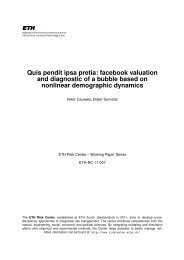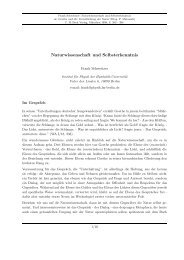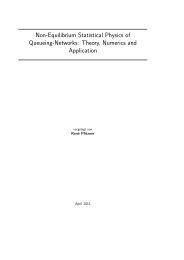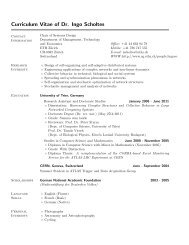Using Laboratory Experiments to Study Law and Crime - Chair of ...
Using Laboratory Experiments to Study Law and Crime - Chair of ...
Using Laboratory Experiments to Study Law and Crime - Chair of ...
You also want an ePaper? Increase the reach of your titles
YUMPU automatically turns print PDFs into web optimized ePapers that Google loves.
However, we still have much <strong>to</strong> learn about the causal mechanisms responsible for thesecorrelations (Sampson 2000). <strong>Labora<strong>to</strong>ry</strong> experiments have strengths in disentangling causalrelations <strong>and</strong> mechanisms that can provide a useful complement <strong>to</strong> more traditional methods.<strong>Labora<strong>to</strong>ry</strong> experiments, for example, can help <strong>to</strong> illuminate mechanisms at the micro-level <strong>and</strong>their aggregation <strong>to</strong> macro- level patterns <strong>of</strong> behavior.How might we move forward in taking advantage <strong>of</strong> the strengths <strong>of</strong> labora<strong>to</strong>ryexperiments <strong>to</strong> increase our underst<strong>and</strong>ing <strong>of</strong> law <strong>and</strong> crime? Criminologists have identified keycorrelates <strong>of</strong> crime. When we have evidence from the field establishing the correlations betweencausal fac<strong>to</strong>rs <strong>and</strong> outcomes, labora<strong>to</strong>ry experiments could be used <strong>to</strong> disentangle the mechanismsresponsible for those correlations (as Rauhut, <strong>and</strong> Cohen <strong>and</strong> his colleagues did in theirexperiments). <strong>Labora<strong>to</strong>ry</strong> experiments might also be used <strong>to</strong> provide an initial test <strong>of</strong> a newtheory. Once there is some supportive evidence from the labora<strong>to</strong>ry, the theory could then beapplied in the field (the approach <strong>of</strong> McAdams <strong>and</strong> his colleagues.While labora<strong>to</strong>ry experiments have high internal validity <strong>and</strong> are very good fordisentangling causal relations <strong>and</strong> mechanisms, they tend <strong>to</strong> have lower external validity. Inparticular, labora<strong>to</strong>ry results typically do not provide data regarding the size <strong>of</strong> effects that wewill observe in the field, or the relative substantive importance <strong>of</strong> different causal fac<strong>to</strong>rs. Othermethods are more useful for addressing those issues. Thus labora<strong>to</strong>ry experiments <strong>and</strong> othermethods have complementary strengths. Adding labora<strong>to</strong>ry experiments <strong>to</strong> our methodologicalreper<strong>to</strong>ire has the potential <strong>to</strong> substantially increase our underst<strong>and</strong>ing <strong>of</strong> law <strong>and</strong> crime.25







